So I’m talking to a neighborhood guy in rural Wisconsin where my wife and I, besotted, purchased one hundred and twelve acres of lovely mixed pasture and woodland a few years ago.
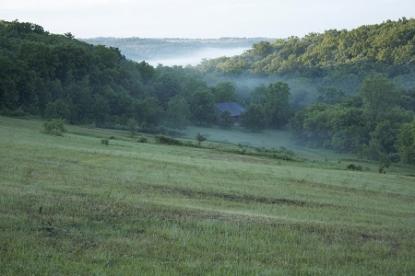
looking south on a portion of our land after mowing
Our land is in a corner of Southwestern Wisconsin – called by geologists the ‘driftless’ zone – which is unique: its landscape alone in the Midwest escaped the physical scouring and flattening of the last ice age ten thousand years ago. In fact, no glacier has covered this area for five hundred thousand years. As a result, its steep hills and valleys, hollows and streams, are shaped by ancient events well before the emergence of human beings.
Cut to the present. “ We’re thinking of planting a weeping willow at the top entrance to our property,” I say innocently to a new neighbor. “Invasive,” he sniffs. About the third time I hear one of the locals muttering about ‘invasives,’ I go off.
Wait a minute, I say a little too loudly, aren’t we all ultimately immigrants? Isn’t this kind of racist? These are mostly steadfastly liberal folk, future governor Walker recallers all, and they are indignant. “You don’t understand,” is the consensus. I have to give them that. I grew up in the Maryland suburbs, and have lived my entire adult life in cities (New York, Chicago, Boston).
My mother addressed all problems of understanding by reading. I remember coming to her home for a vacation visit once at a time when my sister had fallen in love with a Senegalese Muslim fellow student in Paris. The parents were not home, but on the dining room table were two pamphlets: The Wolof Culture; and Miscegenation.
I am my mother’s son. So I read. Along the way, I meet John and Martha Lunz, who are native plant restorationists in Milwaukee. Subsequently, they send me a fascinating book: Bringing Nature Home, by Douglas W. Tallamy. Well meaning horticulturalists, Tallamy explains, import a great many ornamental plants for suburban gardeners, favoring those from far away which are “pest free.” That is, the plants are imported, but their insects are not. “So what,” was my first thought. When I pondered insects diets at all, which was not often, I assumed them to be omnivores . Actually, It turns out, nothing could be further from the truth. Insects are extraordinarily conservative. They mostly only eat what they’ve always eaten, and they tend to ignore new arrivals, no matter how leafy, sometimes, as in the case of the Norway Maple, for instance, for hundreds of years after they arrive.
This is not a big deal in the suburbs, where gardeners can easily keep control of their tiny yards. The trouble begins when, inevitably, many of these newly arrived ornamentals subsequently ‘escape cultivation’ and, transferred out of suburban yards by birds, wind, shoes, etc, begin to grow in natural, i.e., relatively uncultivated areas everywhere. Again, so what? Doesn’t this add to bio-diversity?
Once again, the answer is no. Rather, these plants tend to replace the native flora. Why replace? Can’t we all get along? Unfortunately, that’s not the way plant evolution works. The new arrivals bring few or none of the insects and pathogens which curb their growth in their original habitat. Therefore, they easily ‘out compete’ the locals, whose resident insects and diseases keep them in check, and eventually the ‘aliens’ take over. The unfortunate result is that local diversity yields increasingly to an invasive alien monoculture.
I couldn’t help thinking about the contrast between ‘alien’ plants and their human counterparts. We torment our resident aliens, the undocumented immigrants. Those we don’t arrest and deport, we graciously allow to do backbreaking labor here, harassing them physically, educationally, legally and financially all along the way. Those who survive have to be really tough.
With floral aliens, the reverse is true. They are coddled. Not by us directly, of course, but by nature, with our considerable assistance. For interestingly, it is not only profit driven nurseries that are responsible for bringing in the aliens. In some of the most famous cases, it is well-meaning governmental entities. This is true of the notorious Kudzu vine, now present in epidemic proportions in the American South. Kudzu was introduced to the U.S. as an exotic Japanese ornamental at the 1876 Philadelphia Centennial Exposition. It caused no great stir until the Federal government started to pay farmers to grow it to prevent erosion in the 1930’s, and its Civilian Conservation Corps planted thousands of acres of it in the Southeastern U.S. With no natural predators, and in climate conditions which turned out to be ideal, Kudzu ultimately choked out shrubs and trees, covered fences, old automobiles and pretty much anything else in its path, leading to its subsequent designation, by the U.S. Department of Agriculture in 1953, as a “pest weed.”
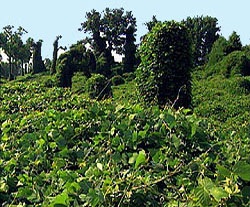
Kudzu rampant in Georgia
Many of our own Wisconsin acres, earlier pasture for dairy cows, are currently home to another runaway alien pest: a shrub called ‘Russian Olive’. It is native to temperate Western Asia (Azerbaijan, Kazakhstan, and Georgia, among other countries). It was imported to the U.S in the 1800’s as an ornamental and a windbreak, before escaping cultivation and flourishing in the Central and Western U.S. Innocently, I liked it at first encounter: it had pretty spring flowers, and seemed popular with birds. Until relatively recently, it was still being planted by the U.S. Soil Conservation Service along rural roadsides as a windbreaking, bird attracting, soil holder. But in Southwestern Wisconsin it is now firmly classified as an ‘invasive alien.’ In the absence of local insect predators, it can grow four feet in a single season , it can survive in an amazing range of temperature (from -50 to 115 degrees Fahrenheit), and its seeds are dispersed widely by its resident birds (although “ecologists have found that bird species diversity is actually greater in areas with a higher concentration of native vegetation)
Russian Olive shrubs following an initial removal effort
Were it just a matter of hundreds of Russian Olive Shrubs growing on abandoned former pasture land, we’d have probably accepted them as inevitable and relatively benign. But on our land, they are competing with a dozen acres or so of native tall grass prairie remnant.
A friend walks along a swath of our tall grass
Tall grass prairie is composed of a half dozen different grasses and many additional native flowers (forbs). The roots of its dominant component, Big Bluestem, go extraordinarily deep, eighteen inches or more. To our surprised eyes, it was also extraordinarily lovely, rising four to five feet high, golden in summer, turning purple in fall, its crown constantly in motion. When deer, which are plentiful, run through it, they resemble dolphins, rising and falling gracefully, legless.
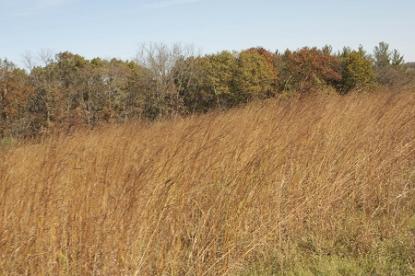
Prairie grass in early fall
Prior to European settlement, prairie lands formed the largest ecosystem in North America, stretching from Canada to Mexico and from Indiana to the Rockies. What is left, after two hundred years of buffalo and Indian extermination, commodity crop production and cattle ranching, is a tiny remnant.
The reason our land has any tall grass at all owes to a program signed into law by Ronald Reagan in 1985: The Conservation Reserve Program (CRP). Grain prices had risen sharply in the 1970’s, causing farmers to plow up millions of acres of marginally productive land to plant commodity crops like corn and soybeans, greatly reducing wildlife habitat. When grain prices fell precipitously in following decade, farms began to fail at rates not seen since the Great Depression. As a side effect, vast amounts of newly cropless land were washed away by erosion.
The CRP paid farmers to keep these highly erodible lands out of commodity production and to re-plant them with the deep rooting prairie grass. When we bought our land, twenty-three acres of it had been put into the CRP program years before, and prairie grass and forbs were still dominant on about twelve of those acres. (The rest were being overtaken by the Russian Olive and another exotic invasive: the multiflora rose bush.)
The scale of the CRP program was considerable. By 2005, it had taken 34 million acres out of commodity cultivation, an area bigger than the state of New York. It was costing U.S. tax payers more than $2 billion dollars a year. Its purpose had also evolved. Starting as an erosion control program, it had morphed into a wild-life preservation and water-quality program.
Needless to say, the CRP is not universally loved. Farm product sellers don’t like it because it reduces demand for fertilizer, pesticides, and fuel. Some hunters, while appreciating the gain in wild-life habitat, resent the fact that despite the fact that their taxes help pay for the program, they can be denied permission to hunt on CRP land at the whim of its owners. But unarguably, the wild-life benefits have been extraordinary. Dave Mommsen, vice-president of Pheasants Forever, a Mid-Western non-profit, recently called the CRP “the most successful conservation program in history,” not only for pheasants but for other game animals like waterfowl, wild turkey, grouse and deer. It also “provides key linkages between larger blocks of native prairie “which are essential for small grassland birds.”
On our land, for instance, the sheltering grass has become a favorite ground fledging site for a remarkable little bird, the bobolink, which returns annually from twelve thousand miles away at the tip of South America to bear and nurture its young.
In addition, because we are in the northern, prairie oak transition area, we have a beautiful oak grove in the middle of the property and a majestic lone oak at the top.
Burr Oak
These are Burr Oaks, which co-evolved with the prairie grasses an extraordinarily thick bark, which enabled them to survive fire. Unsurprisingly, under our Oaks were a gaggle of shade loving invasives led by honeysuckle, another pretty alien shunned by local insects.
Recently, with grain prices again rising and the federal budget deficit rising as well, the CRP has become a political football. Our twenty-three acres were abruptly removed from the CRP program in 2008. But then, last year, we were allowed to re-bid on a ten year contract if we agreed to re-plant grasses and forbs in the part of the original land which was falling to invasives.
As it happened, we had already, in love with our tall grass remnant, decided to restore as much prairie as we could, and I had, with some help from Jake Venden, our resident hunter, had cut down or taken out over one hundred and fifty Russian Olive shrubs.
dragging Russian Olive branches to a burn pile
This was hard work, but now, I thought, we should be close to ready to broadcast prairie seed and await the return of the tall grass. Still, I reckoned, we should hire an expert to supervise our CRP application and to guide our planting. It was at this point I first heard about a young prairie restorationist who lived nearby: Andrea Nelson.

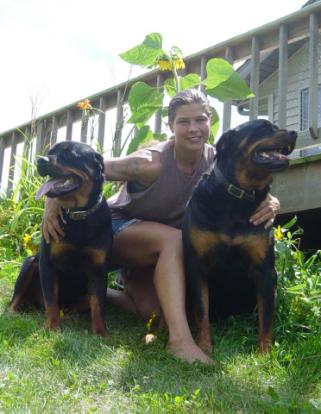
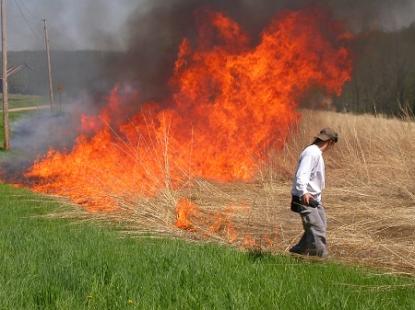
boxer with puppies burning prairie
Andrea, who is the daughter of a University of Wisconsin professor, is no academic. She is a former boxing champion, the best woman fighter in the Midwest before she retired a few years ago (she continues to train boxers in a Madison gym), runs miles daily, does not wear shoes except when absolutely necessary, is inked up, and is passionate about prairie restoration. Because of her ink and her fierceness, I could not help asking her if she had read or seen The Girl With the Dragon Tattoo. She had not.
Andrea quickly disabused me of any notion that restoring our prairie, and in our case, an oak grove understory as well, was going to be easy. It might not even be possible. This was confirmed by other sources as well. Michael Whaley, a friend and teacher at the nearby Frank Lloyd Wright School of Architecture, whose wife Gigi is also a prairie restorationist , vividly described to me her principal task as “grief counseling.” In her case, it is mainly because of the difficulty of eradicating invasive Garlic Mustard from her clients’ – and her own – land.
There was absolutely no point, Andrea said, in planting anything on our land until all the invasives had been set back (elimination, I noticed, did not seem to be in her vocabulary). To accomplish that, she said, would take several growing seasons and would require us to attack them with three different techniques: mowing, burning and poisoning. My Russian Olive removal work, she observed, was a quaint and largely ineffectual drop in the bucket. Putting a chain around and pulling them out by the roots with my tractor, as I had been proudly doing, was a pretty good way of spreading their seed as I dragged them to a burn pile, she added. And in any case, there remained massive olive infestations in the prime area for re-seeding. She recommended I hire someone with a massive flail mower to make an initial pass through this area, about eleven acres, reducing the Olive bushes to stumps , each one of which I was to try to treat with the herbicide glyphosate (think Roundup) within twenty minutes of cutting.
I was stunned. To me, a former Vietnam War activist, herbicides of any sort called up memories of Agent Orange. Were we going to have to kill our prairie to save it? Andrea shrugged. It was my choice, she said, but even if we could ultimately win the battle over invasives without resorting to poison, it might take a generation to see any significant new prairie.
Glyphosate works by being sucked into the roots of the plant while it is still alive, inhibiting an enzyme it uses to make certain necessary amino acids. Monsanto developed it in 1970, and since it has become the herbicide of choice for millions of American farmers, dovetailing beautifully with genetically modified corn and soybean seeds developed by – surprise, Monsanto – to be unaffected by glyphosate. The crops that grow from these seeds are, in Monsanto marketing jargon, Roundup ready. This means farmers can poison all their weeds without harming their crops, which dramatically increases productivity. Over the long course of its use, many academic studies have been done, most of which conclude that glyphosate does not harm animals, including humans, because our bodies use a different amino acid pathway from plants. It also has a very short half-life in the ground (the drier, the shorter), hence does not affect much beyond the target plants. Both the EPA and the USDA have certified it for use. (Caution is strongly advised for use near water, where the decay rate is much slower. )
However, as recently as January of this year, a retired plant pathologist from Purdue University , Don Huber, wote an open letter to Secretary of Agriculture Tom Vilsack requesting an ‘immediate moratorium on the deregulation of Roundup Ready crops” pending more research into the discovery of a tiny “electronic microscopic pathogen [in Glyphosate] that appears to significantly impact the health of plants, animals and humans.” When Vilsack did not respond, Huber made his letter public and it has since gone viral, becoming fuel for a “firestorm” in the anti-GMO blogosphere.
Notwithstanding, a plurality of weed scientists, agronomists and pathologists have so far not supported Huber’s claims, and the majority of prairie restorationists, with Andrea, continue to recommend its limited use as well, despite concerns that extensive use is going eventually to lead to weed immunity.
Ultimately, I caved. Were I younger, I think I would have eschewed the poison route. But being old, I would not live to see the results of so doing. As a compromise, I asked Andrea to not treat the upper oak understory chemically, only the lower oaks along with the Russian Olive, so we would at least have a basis for comparison. She readily agreed, having come only reluctantly to a pro chemical position herself.
Accordingly, we hired a local operator to go over eleven acres with a huge flail mower, which could mow down wood up to several inches in diameter. I followed behind with an ingenious poisoning wand designed and fabricated by Andrea, applying the glyphosate to as many stumps as I could within the twenty minute window.
Once the flail mower had done its work, it was my turn to mow. (I had been dying to own a tractor ever since I learned how to drive on one at age twelve on a summer vacation at a nearby school run by my grandfather. Now, I finally had an excuse to get one. We had bought a lovely, beat-up 1993 Ford 2120 four wheel drive utility tractor, to which I alternately attached a ‘bush hog’ for rough mowing and a finish mower, for paths.)
So I mowed the eleven acres myself, not without incident since the acreage was still a mess of Russian Olive stumps, tough weeds and in addition had been previously terraced, which made it rough on the tractor, the mower, and my body, all of which got damaged but were reparable, the former two with money, the latter with time. (I am a naturally careless person, but if you turn over a tractor and you do not have a securely fastened seat belt, you die, as the developer of the Mini Cooper demonstrated a couple of years ago, so I have so far been uncharacteristically careful.)
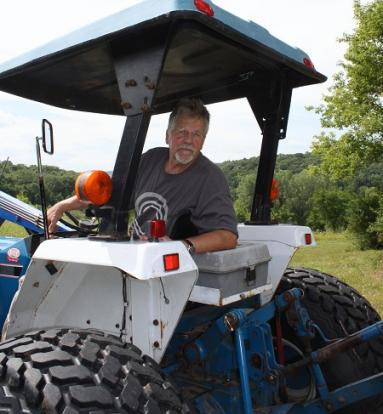
Ford 2120 with turf tires
Then, with Andrea’s guidance, we bought over a million seeds of mixed warm season grasses and forbs, and planted them, employing a seed drill pulled by her father, Phil, on a more powerful tractor than mine, to simultaneously make furrows and drop seed.
Andrea and her father with seed, drill
But that’s only the beginning. We will see no results until next summer. And since few native prairie species are able to survive the competition of established weedy vegetation I would have to do repeated mowing to give them a chance germinate and compete. I did two more mowings in the course of the summer. Mowing is absolutely key to establishing, then maintaining diversity. (An experiment at the Prairie Creek Widlife refuge in Iowa demonstrated that regular mowing yielded – after the third growing season – 27 different species, whereas unmowed land planted with the same seed yielded only 8.)
Having mowed and seeded those eleven acres, we then burned that part of the property where the warm season grasses were better established . Burning returns old, dead grass to the soil where its ash is better able to furnish nutrients for new growth, particularly of Big Bluestem, the keystone prairie grass. It also inhibits the growth of woody brush, like Russian Olive and trees, particularly when done in the fall.
Can it get out of hand? Easily, which is why Andrea prepared a comprehensive burn plan, waited patiently for the right weather and wind conditions, and got the participation of the local village fire department which, since it was “good training for the men,” the fire chief, Joe Thomas, generously donated.
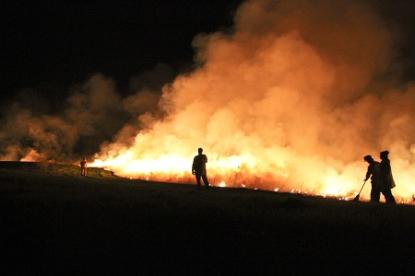
our first burn (photo by Venden Photo)
We will do another burn this spring, and probably once every couple of years for the next few.
So we are launched.
Andrea’s father, Phil, enjoys tweaking her and me as well. “You know Tim,” he said, “tall grass is completely sterile.” “What do you mean?” I said. “Nothing eats it. The deer eat the forbs (flowers), but won’t touch the grass.” Then he added: “Well, there is one creature that eats it.”
What would that be, I ask innocently. “Buffalo,” he answers with a twinkle. This opened up a new and unpleasant vista. It wasn’t only the alien invasives we had to worry about: it was native plants out competing other natives. I had this sudden fantasy of needing to bring buffalo onto our prairie to control the Big Bluestem, then having to import Native Americans to hunt them so they didn’t destroy it completely, then having to send the invading settlers back to Europe to prevent them from exterminating the Native Americans, and on and on….
I looked at Andrea. “Is that true?” Yes, she said complacently, but no need to worry about it. We just need periodically to ‘overseed’ forbs to rebalance the competitive scale. (Actually, I have since found that cattle will eat tall grass as well, but ranchers who raise grass fed beef prefer to feed them cold season grasses rather than warm season prairie grass.)
In a final irony, even when a prairie has been successfully ‘restored,’ it is not stable, as Chris Helzer points out in an essay on “The Myth of Self-Sustaining Prairies.” For prairies are probably not what ecologists call ‘climax communities.’ Most likely, prairies are historically an ‘ephemeral stage of a longer successional process’ which ultimately yields — forests. ‘Most likely’, because prairies have not existed long enough to be certain what they would have become without human intervention.
The great prairies of the nineteenth century had only been around since the last ice age, about ten thousand years. During that whole time, humans have been actively managing them. Native Americans, for instance, set many more fires than would have occurred from lightning alone. And the Bison, feasting on the newly greened shoots arising in the recently burned areas, grew to herds of millions, providing in return vast amounts of protein to the fire starters. What kept prairies prairies, therefore, were “disturbances.” The principal disturbances were: fire, grazing and drought, which the tall grass had evolved to survive.
So we, in our little corner of the driftless zone, are just the latest in a long line of disturbers, fighting with slightly higher tech tools to bring back an ultimately unstable prairie. It is difficult and expensive work. Is it significant? Not really, unless you are a bobolink, or a hunter. We are neither, and yet nothing I do gives me more pleasure.
Why, I wonder? I do remember reading a lovely essay by George Orwell a long time ago about a venal seventeenth century clergyman in England – the Vicar of Bray – who cheated his parishioners, yet who also planted a magnificent stand of oaks in the parish church yard which gave Orwell immense pleasure sitting among them some three hundred years later, long after the vicar’s venal sins were forgotten. Accordingly, Orwell concluded, whenever you commit an anti-social act, it would be a good idea for you to plant a tree.


